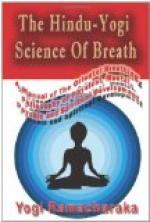The blood starts on its arterial journey, bright red and rich, laden with life-giving qualities and properties. It returns by the venous route, poor, blue and dull, being laden down with the waste matter of the system. It goes out like a fresh stream from the mountains; it returns as a stream of sewer water. This foul stream goes to the right auricle of the heart. When this auricle becomes filled, it contracts and forces the stream of blood through an opening in the right ventricle of the heart, which in turn sends it on to the lungs, where it is distributed by millions of hair-like blood vessels to the air cells of the lungs, of which we have spoken. Now, let us take up the story of the lungs at this point.
The foul stream of blood is now distributed among the millions of tiny air cells in the lungs. A breath of air is inhaled and the oxygen of the air comes in contact with the impure blood through the thin walls of the hair-like blood vessels of the lungs, which walls are thick enough to hold the blood, but thin enough to admit the oxygen to penetrate them. When the oxygen comes in contact with the blood, a form of combustion takes place, and the blood takes up oxygen and releases carbonic acid gas generated from the waste products and poisonous matter which has been gathered up by the blood from all parts of the system.
The blood thus purified and oxygenated is carried back to the heart, again rich, red and bright, and laden with life-giving properties and qualities. Upon reaching the left auricle of the heart, it is forced into the left ventricle, from whence it is again forced out through the arteries on its mission of life to all parts of the system. It is estimated that in a single day of twenty-four hours, 35,000 pints of blood traverse the capillaries of the lungs, the blood corpuscles passing in single file and being exposed to the oxygen of the air on both of their surfaces. When one considers the minute details of the process alluded to, he is lost in wonder and admiration at Nature’s infinite care and intelligence.
It will be seen that unless fresh air in sufficient quantities reaches the lungs, the foul stream of venous blood cannot be purified, and consequently not only is the body thus robbed of nourishment, but the waste products which should have been destroyed are returned to the circulation and poison the system, and death ensues. Impure air acts in the same way, only in a lessened degree. It will also be seen that if one does not breathe in a sufficient quantity of air, the work of the blood cannot go on properly, and the result is that the body is insufficiently nourished and disease ensues, or a state of imperfect health is experienced. The blood of one who breathes improperly is, of course, of a bluish, dark color, lacking the rich redness of pure arterial blood. This often shows itself in a poor complexion. Proper breathing, and a consequent good circulation, results in a clear, bright complexion.




